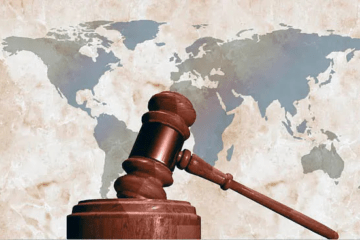
This article is written by Shruti Jainof 5th semester of BALLB of Delhi Metropolitan Education Affiliated To Guru Gobind Singh Indraprastha University, an intern under Legal Vidhiya
ABSTRACT
Environmental problem is an international problem that go by national boundaries and develops into regional and global environmental pollution and ecological problems. Facing the increasing environmental pollution, the international community has continuously formulated many environmental pollution prevention laws, but the world situation is complicated after all, environmental problems still emerge endlessly, and the protection of environmental rights has become the concord of the international community. Environmental right is an essential part of human rights, and protecting environmental right is the concrete expression and proper meaning of protecting human rights. Using international criminal law to protect environmental rights will play a positive impact in global environmental protection. As with the development of computer technology, the research of machine learning has slowly transferred to the field of social science, especially the judicial field. While sentencing is a vital part of environmental crime, this paper studies the sentencing of environmental rights cases from the outlook of international criminal law.
KEYWORDS: International Environmental Law, Justice, United Nations Environment Programme (UNEP), environmental matters and policy
INTRODUCTION
International environmental law plays a crucial role in addressing environmental crimes, shaping policies, and promoting justice on a global scale. It encompasses legal frameworks and agreements that aim to protect the environment, prevent harm, and ensure sustainable development. Environmental crimes refer to activities that cause significant harm to the environment, such as illegal wildlife trafficking, illegal logging, pollution, and illegal disposal of hazardous waste. International environmental law provides a framework to define and address these crimes, holding individuals and entities accountable for their actions. In addition to addressing environmental crimes, international environmental law also focuses on policy development. It establishes guidelines and standards to regulate activities that may impact the environment, such as emissions control, conservation of biodiversity, and sustainable resource management. These policies aim to promote sustainable practices and mitigate environmental degradation. Justice is a fundamental aspect of international environmental law. It seeks to ensure fairness and equity in the enforcement of environmental laws and the resolution of disputes. This includes providing access to justice for affected individuals and communities, as well as holding responsible parties accountable for their actions through legal mechanisms and remedies. Overall, international environmental law combines the principles of crime prevention, policy development, and justice to address global environmental challenges and create a more sustainable and equitable future for all.
DEFINITION AND CONSEQUENCES OF ENVIRONMENTAL CRIMES
Environmental crimes encompass a range of illegal activities that directly harm the environment. These can include activities like illegal dumping of hazardous waste, illegal wildlife trade, illegal logging, and pollution of air, water, or soil. The consequences of these crimes are far-reaching and severe. They can lead to the destruction of ecosystems, loss of biodiversity, contamination of water sources, air pollution, and negative impacts on human health. Additionally, environmental crimes contribute to climate change and exacerbate global environmental challenges. It is crucial to combat these crimes through enforcement of environmental laws, raising awareness, and promoting sustainable practices.
Some examples of environmental crimes include illegal dumping of hazardous waste, illegal logging and deforestation, wildlife trafficking, illegal fishing, pollution of air, water, or soil, and illegal mining. These activities have detrimental effects on the environment and contribute to the degradation of ecosystems and loss of biodiversity. It is important to combat these crimes through enforcement of environmental laws and promoting sustainable practices.
ROLE OF INTERNATIONAL LAW IN ADDRESSING ENVIRONMENTAL CRIMES
International law plays a crucial role in addressing environmental crimes. It provides a framework for cooperation among nations to tackle transboundary environmental issues and establish standards for environmental protection. Treaties and conventions, such as the United Nations Framework Convention on Climate Change (UNFCCC) and the Convention on International Trade in Endangered Species of Wild Fauna and Flora (CITES), aim to regulate and prevent environmental crimes on a global scale.
These international agreements establish guidelines for the conservation of natural resources, the prevention of pollution, and the protection of biodiversity. They facilitate cooperation between countries in sharing information, conducting joint investigations, and enforcing laws against environmental crimes. Additionally, international law provides mechanisms for resolving disputes and holding perpetrators accountable for their actions.
Furthermore, international organizations like the United Nations Environment Programme (UNEP) and INTERPOL play a vital role in coordinating efforts, providing technical assistance, and promoting collaboration among nations to combat environmental crimes. They facilitate capacity building, training, and knowledge sharing to enhance the effectiveness of law enforcement agencies in addressing environmental crimes. Overall, international law serves as a crucial tool in addressing environmental crimes by fostering cooperation, establishing standards, and facilitating enforcement and accountability on a global scale.
INTERNATIONAL ENVIRONMENTAL POLICY FORMATION
International environmental policy formation involves the development and implementation of agreements, laws, and regulations at the global level to address environmental issues. It is a complex process that involves multiple stakeholders, including governments, international organizations, non-governmental organizations, and scientific experts.
The formation of international environmental policies typically begins with the identification of a pressing environmental issue that requires global cooperation. This can be done through scientific research, assessments, and reports that highlight the urgency and severity of the problem.
Once the issue is identified, negotiations take place among countries to develop agreements and treaties. These negotiations often occur within the framework of international organizations such as the United Nations Environment Programme (UNEP) or the United Nations Framework Convention on Climate Change (UNFCCC). During the negotiation process, countries discuss and negotiate the terms, goals, and actions needed to address the environmental issue.
After negotiations, countries that agree to the terms of the agreement sign and ratify it, indicating their commitment to implementing the agreed-upon measures. The agreement then becomes legally binding and sets the stage for the implementation and enforcement of the policies.
Implementation of international environmental policies involves the adoption of domestic laws and regulations by individual countries to align with the agreed-upon goals and actions. Countries may establish regulatory frameworks, set emission reduction targets, create monitoring and reporting systems, and allocate resources to implement the policies effectively.
International organizations play a crucial role in supporting countries in implementing and monitoring the policies. They provide technical assistance, capacity building, and financial support to help countries meet their commitments. These organizations also facilitate cooperation, knowledge sharing, and the exchange of best practices among countries.
Regular reviews and assessments are conducted to evaluate the progress made in implementing the policies and achieving the desired environmental outcomes. Adjustments and revisions may be made to the policies based on the findings of these reviews.
In summary, international environmental policy formation involves the identification of environmental issues, negotiations among countries to develop agreements, implementation of domestic laws and regulations, and ongoing monitoring and evaluation. It is a collaborative and ongoing process aimed at addressing global environmental challenges and promoting sustainable development.
KEY PRINCIPLES AND INSTRUMENTS OF INTERNATIONAL ENVIRONMENTAL LAW
International environmental law is guided by key principles and instruments that shape its framework. Some of these principles include the principle of sustainable development, which emphasizes the need to meet present environmental needs without compromising the ability of future generations to meet their own needs. Another principle is the principle of common but differentiated responsibilities, which recognizes that countries have different capacities and historical contributions to environmental issues.
Instruments of international environmental law include treaties, conventions, protocols, and agreements that establish legally binding obligations for countries. These instruments address a wide range of environmental issues such as climate change, biodiversity conservation, marine pollution, and hazardous waste management.
For example, the United Nations Framework Convention on Climate Change (UNFCCC) is an international treaty that aims to stabilize greenhouse gas concentrations in the atmosphere. Its key instrument, the Paris Agreement, sets targets for reducing greenhouse gas emissions and provides a framework for countries to enhance their efforts over time.
The Convention on Biological Diversity (CBD) is another important instrument that promotes the conservation and sustainable use of biodiversity. It establishes goals and targets for biodiversity protection and encourages countries to develop national strategies and action plans.
The Basel Convention on the Control of Transboundary Movements of Hazardous Wastes and Their Disposal addresses the management and disposal of hazardous wastes. It sets out guidelines for the environmentally sound management of such wastes and promotes cooperation among countries to minimize their adverse effects.
These are just a few examples of the key principles and instruments of international environmental law. They serve as a foundation for global cooperation and action to address environmental challenges and promote sustainable development.
PURSUIT OF JUSTICE IN INTERNATIONAL ENVIRONMENTAL LAW
In the pursuit of justice, international environmental law plays a crucial role. It provides a framework for holding individuals, organizations, and even states accountable for environmental crimes and violations. Environmental crimes can include activities such as illegal wildlife trafficking, illegal logging, and illegal waste dumping.
International environmental law establishes legal mechanisms to address these crimes and ensure that those responsible are held accountable. It provides avenues for cooperation between countries in investigating and prosecuting environmental offenders. Additionally, it promotes the sharing of information and evidence to strengthen the enforcement of environmental laws. Consequences for environmental crimes can vary depending on the severity of the offense and the jurisdiction in which it occurs. They can range from fines and penalties to imprisonment. The goal is to deter individuals and entities from engaging in harmful activities that degrade the environment and harm ecosystems.
Examples of environmental crimes include illegal fishing practices that deplete marine resources, illegal trade in endangered species, and the illegal disposal of hazardous waste. These activities have significant negative impacts on the environment, biodiversity, and human health.
By upholding principles of justice and accountability, international environmental law strives to protect the planet, its ecosystems, and future generations. It promotes a sustainable and equitable approach to managing and preserving our natural resources.
ACCESS TO JUSTICE AND ENVIRONMENTAL RIGHTS
Access to justice is crucial for ensuring the protection of environmental rights. It allows individuals and communities to seek legal remedies and hold those responsible for environmental harm accountable. Environmental rights encompass the right to a clean and healthy environment, the right to participate in environmental decision-making, and the right to access information related to the environment.
By having access to justice, individuals can challenge actions or policies that may negatively impact the environment and their rights. This can include filing lawsuits, participating in public hearings, or engaging in advocacy efforts. It helps to ensure that environmental laws and regulations are effectively enforced and that environmental justice is upheld.
To enhance access to justice in environmental matters, it is important to have transparent and accessible legal frameworks, as well as mechanisms for legal aid and support. This can help overcome barriers such as financial constraints and lack of legal knowledge.
By promoting access to justice and protecting environmental rights, we can work towards a more sustainable and equitable future, where everyone has the opportunity to live in a clean and healthy environment.
DISPUTE RESOLUTION MECHANISMS AND ACCOUNTABILITY
Dispute resolution mechanisms and accountability are essential in ensuring fair and just outcomes in environmental matters. These mechanisms provide a way to resolve conflicts and disputes related to environmental issues, while holding parties accountable for their actions.
In the context of environmental disputes, various mechanisms can be utilized, such as negotiation, mediation, arbitration, and litigation. These mechanisms aim to facilitate dialogue, find common ground, and reach mutually acceptable solutions. They help avoid prolonged conflicts and promote sustainable resolutions.
Furthermore, accountability is crucial in environmental matters to ensure that those responsible for environmental harm are held liable for their actions. This can involve legal consequences, financial penalties, or the implementation of corrective measures to mitigate the damage caused.
By utilizing effective dispute resolution mechanisms and promoting accountability, we can work towards resolving environmental conflicts, promoting sustainable practices, and safeguarding our natural resources for future generations.
CONCLUSION
At last, I want to conclude that, International criminal law plays a unique role in the protection of environmental rights. Using international criminal law to protect environmental rights is compatible with the current general promotion of human rights. In this article, CNN is used to review the sentencing of environmental rights from the perspective of international criminal law, including the prediction of the sentencing term and fine. The corresponding sentencing term or fine is acquired through the description of environmental rights case text. To make the prediction effect of the sentencing term or fine more clearly exhibit, the distance between the predicted sentencing term or fine and the true value is considered to construct the score; thus, the assessment and analysis of the predicting effect of the model can be realized, and the instance basis can be provided for the selection of different assisted sentencing models. International environmental law, with its focus on addressing environmental crimes, shaping policies, and promoting justice, plays a crucial role in protecting our planet. It defines and addresses activities that cause significant harm to the environment, holds individuals and entities accountable for their actions, and establishes guidelines for sustainable practices. By enforcing laws, developing policies, and ensuring access to justice, international environmental law aims to create a more sustainable and equitable future for all. Together, we can work towards preserving our environment and fostering a global commitment to environmental stewardship. International environmental law serves as a crucial tool for addressing environmental crimes, shaping policies, and seeking justice. Through effective international cooperation, the global community can tackle pressing environmental issues and safeguard the planet for future generations. By recognizing the interconnectedness between environmental protection, crime prevention, policy formation, and justice, we can strive for a sustainable and equitable future for all.
REFERENCES
- https://www.ncbi.nlm.nih.gov/pmc/articles/PMC9173897/ visited on 20-08-2023
- https://escholarship.org/content/qt0ph8h7r5/qt0ph8h7r5.pdf?t=mv6l8s visited on 22-08-2023
- https://www.cairn.info/revue-internationale-de-droit-penal-2006-1-page-255.htm visited on 23-08-2023




0 Comments